Sue Burke's Blog, page 21
March 2, 2022
I’ve been birdwatching
 With chimney smoke and snow
With chimney smoke and snow At midday
At middayOne of my hobbies is birdwatching, and I’ve been making careful observations of a bird perched on the corner of a building about a half-block from my apartment. I’ve identified it as the Common Bobblehead Owl, Caput nutans imitator bubonis.
It’s a faux horned owl; generic brown, white, and buff plumage; glaring yellow eyes; plastic. Height: 14.5 inches plus base; wingspan unknown. Voice: silent. Habits: stationary; head rotates in wind. Prey: gardeners and property owners. Does not reproduce; must be replaced. Worldwide distribution; origin China; migration aided by Walmart and by vendors on Amazon.
I first noticed the bobblehead roosting on the ledge late last year after some maintenance work on the building’s roof. So far, the faux owl has caused no change to the habits of the neighborhood birds, who didn’t frequent that roof anyway, although I recently observed pigeons landing nearby on the ledge to stare inquisitively. Bobblehead observers in Australia have noticed similar effects.
For me, the little sculpture adds a philosophic note to the daily view from my window of the traffic, trees, roofs, and sky. I see pugnacious crows, soaring hawks and falcons, migrating geese, busy songbirds, and flocks of idle pigeons. The bobblehead owl was meant to serve a purpose that wasn’t needed and isn’t being fulfilled. Vanity of vanities.
Note: Yes, caput nutans means “bobblehead” in Latin. I looked it up.
Photo: I don’t own a real camera with a zoom lens. Instead, I have a little telescope, and I took the photos by holding my mobile phone to the eyepiece. Turned out pretty good, I think.
February 23, 2022
Rules for beauty, Spanish vs. English

Last week I mentioned the challenge of translating the novel Prodigies by Angélica Gorodischer for Small Beer Press. She deliberately chose to write the book in a formal style of Spanish that strives for beauty.
However, standards of beauty for Spanish and English share little in common due to the different histories of each language as well as the different possibilities and limits of their grammar and vocabularies. Beauty had to be transformed.
Spanish emerged from a local dialect of Latin. King Alfonso X “the Wise,” who reigned from 1252 to 1284, made Spanish (Castilian, to be precise) the preferred language for scholarship in his realm, replacing Latin. To cement that change, he funded scholars in Toledo and elsewhere to translate literature from other languages into Spanish and to write new books. He himself wrote some important works, knowing that a language must have literature.
Fine writing style in Spanish still echoes its scholarly roots: formal and elaborated. Above all, good style rejects repetition. Vocabulary and syntax should be richly varied. Spanish grammar permits long, ornate sentences, because the verbs are fully conjugated and the nouns and adjectives are gendered, so subordinate clauses can be easily looped together like tatted lace.
English, on the other hand, has suffered a more checkered history. After the Norman invasion in 1066, Norman French became the dominant language in Britain, and English was shattered into regional dialects. As Modern English eventually began to emerge, it was shaped by two formidable literary landmarks: Shakespeare and the King James Bible.
The Bard of Avon began writing plays in about 1592, adding lively new words and expressions that we still use today. We all speak “the language of Shakespeare” — which is how Spaniards often refer to English (to avoid repeating the word English).
But even more important in the development of English, the King James Bible was published in 1611. Its constant use as the single major work of literature readily available to ordinary people made it the standard and model for their language. For us, it’s hard to imagine how central this book was, even to illiterate people, but we can hear still its influence.
Its translators had produced majestic but direct, unornamented prose meant for ordinary people, not scholars, and they stuck close to the syntax of the original languages, notably Hebrew in the Old Testament.
Many of those Bible verses were poetry, and Hebrew poetry does not rhyme; instead, it uses parallel, balanced structures of phrases or ideas, and of words or rhythms. The second half of a parallel may paraphrase its first half; it may give a consequence; it may contradict the first half; or it may add stronger clauses or sentences that lead to an apex. Rhythm can make the prose musical.
We can hear this in the Book of Ruth: “whither thou goest, I will go; and where thou lodgest, I will lodge: thy people shall be my people, and thy God my God.”
Because of the echo of Hebrew poetry in Modern English, careful repetition and parallel structure strike our ears as beautiful. The two most famous speeches of the 20th century, “I Have a Dream” by Martin Luther King Jr., and “Blood, Sweat, and Tears” by Winston Churchill, demonstrate the power and melody of repetition.
With that in mind, I sought to preserve the beauty in Gorodischer’s novel and her dense, very Spanish prose. Here’s an example from Chapter 15:
“…en algunas casas se cerraron púdicas las cortinas no fuera que ese sol desmesurado y lejos de lugar y medida, como despanzurrando sobre los parquets y los tapices, fuera a desteñir los tapizados y peor, a dar que pensar aguijondeando la piel de los antebrazos y detrás de los lóbulos de las orejas a las niñas vigiladas y obedientes que cambiaban, también en esa época como el sol…”
“The sun came out over a grayish world in a resentful winter, and nothing could be done about it: in some houses the curtains were chastely closed because this sun, excessive and out of place and propriety, might burst on parquet floors and tapestries, might fade the fabric, and worse, might strike the skin on the forearms and behind the earlobes of protected and obedient girls, inciting their thoughts, girls who also transformed in that season like the sun…”
Using a little repetition, I sought to set the words to a different tune and make them sing as sweetly. There were alternatives, of course.
One problem — or possibility, depending on how you look at it — involves the translation of the word fuera, which is the past tense third person singular subjunctive form of “to be.” Spanish subjunctive can be translated in many ways, often with difficulty because the use of subjunctive in English is much more limited than in Spanish. Of the various ways to render it, each requires additional changes in the syntax. One possible way, and a more literal translation, is:
“…in some houses the chaste curtains were closed to prevent this sun, excessive and out of place and propriety, as it was bursting on parquets and tapestries, from fading fabric and worse, inciting thoughts as it was striking skin on the forearms and behind the earlobes of the protected and obedient girls who also changed in this season like the sun.”
Although this is perfectly acceptable, to my ear it sounds ordinary, unlike the original prose, which sounds extraordinary. I hear too many present participles (-ing words), and while repetition of grammatical forms is good, these do not all fulfill the exact same grammatical role: they’re not parallel.
Instead, in my final version, I tried to find a way to unite as many verbs as I could under the modal might. Its use to express weak probability at times can convey the sense imparted by Spanish subjunctive. I chose might burst, might fade, might strike, and deliberately repeated might to make sure the reader understood the relationship among the verbs.
The passage also focuses on the girls of the households, who must be kept chaste and unchanged. So rather than say who toward the end of the sentence, I found a way to repeat girls and thus place a bit more emphasis on them.
In the process, I did not follow the original word for word. Instead, I followed it idea for idea within the artistic intent of the author. I hope that for the reader, I recreated the beauty of the text of the novel and its extraordinary characters and magical setting.
February 16, 2022
Angélica Gorodischer’s “difficult book”
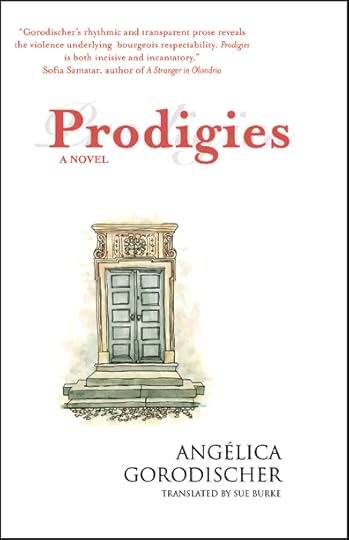
Sad news: Angélica Gorodischer, a prolific and award-winning Argentinian author, died on February 5 at age 93. Three of her books are available in English: Kalpa Imperial, translated by Ursula K. LeGuin in 2003; Trafalgar, translated by Amalia Gladhard in 2013; and Prodigies, translated by me in 2015.
After I finished my translation of Prodigies — an enchanted and enchanting novel — she and I exchanged a few emails. She told me she wrote the book almost as a dare. Here’s a translation of a portion of one of those emails:
“Prodigies is a difficult book. It was hard to write. It began as an argument with a colleague. She maintained that it isn’t possible to write a novel contrary to one’s own tastes, one’s own inclinations; against the grain, so to speak. I said that yes, not only could it be done, but from time to time it must be done, or at least it’s healthy to go against one’s own self and write as pure craft. No you can’t, yes you can, it’s impossible, don’t try to kid me, of course it’s possible, and that’s where it stood.
“But I was left on edge and decided that at some point I was going to write a novel, a full and complete novel, to prove what I had argued in that conversation. And sooner rather than later I set about writing Prodigies. And as I told you: it was difficult. It was difficult, but I liked it.”
She added, “I write in order to write, and that makes me happy.” As for me, “I hope that you’re well, you’re happy, and the goddesses are propitious to you.”
May those goddesses carry her gently to her rest.
***
All three of her books translated into English were published by Small Beer Press. At her passing, Gavin Grant, the publisher, wrote about meeting and working with Angélica Gorodisher.
***
Was Prodigies difficult for me to translate? Yes and no. The prose was lush, complex, and beautiful, and I focused on bringing those qualities into English. Each language operates under different “rules” for beauty, and I needed to translate with those differences in mind — difficult, but I liked it, too.
These are the opening words to Prodigies:
On the day Madame Nashiru arrived at the boarding house on Scheller Street, a brief tremor passed through the house, unnoticed by everyone except Katja. The foundations of the world did not shudder, plagues did not break out, first-born did not die, there were no catastrophes, the waters of the Genil River did not inundate a dozen towns, black death did not arrive at Addis Ababa, the sorcerers of Yauyuos did not dream about dogs with human heads, the walls of Nerja Cave did not crack, ships did not sink in the inlets of Baffin, volcanoes did not erupt, islands did not disappear, orchards did not suffer drought, the lintels of old cathedrals did not become besooted, cemetery guards did not worry needlessly, nor did police officers or transportation inspectors or sergeants or jailors or tax collectors or judges or executioners; but the house shook, and Katja, who was in the courtyard bending over a tin-plate pan, looked at the water and told herself that there are beings with wings and yet they hide them. She did not know what she meant by that, but she was used to those sudden obscure thoughts, so she was not frightened…
February 9, 2022
Autobiography of memory foam

Soft and springy: I was born that way, as polyurethane foam should be, a comfort to all, forgiving to those in need of a cushion. I had a noble purpose.
At least, I thought I had a purpose. I thought I knew who I was.
Soon I came under pressure. At first, I sprang back. I could handle it. I was a service to others, and I was proud.
But I had a hidden side, hidden even to myself, a built-in internal stickiness, a limit to my abilities. I could not spring back forever … or even for very long.
Pressure defeated me, left me flat, unyielding, useless. I lost my purpose in the world … and too soon, I will crumble into dust.
Now I can only remember soft days and soothing nights. Apparently, that’s what my name means. Memory foam is merely the memory of foam.
February 2, 2022
Where to find me at Capricon 42

You’ll be able to find me in a variety of places at Capricon 42, a four-day science fiction convention held annually in the Chicagoland area. This year it will be from February 3 to 6 at the Sheraton Grand Chicago Riverwalk hotel downtown — in person with proof of vaccination and a high-quality mask. (Also with a virtual component. See you there, too!)
You can find me on some panels, and I’ll wander through the dealer’s room and art show looking for unique purchases. In the evening, I hope to pop into a few parties to meet old friends and make new ones. If you’re at Capricon, say hello!
My schedule:
How to Moderate Panels, Missouri Room, Friday, 2:00 p.m. Great moderation can make the difference between a mediocre panel and a fantastic one. Janice Gelb, moderator; Sue Burke, Helen Montgomery, Brother Guy Consolmagno.
Writing Serial Fiction, Huron Room, Friday, 6:00 p.m. Serialization has come to dominate many corners of science fiction and fantasy. What unique challenges does it present and how can they be managed or even used to make a work better? Mark Huston, moderator; Bob J. Koester, Kathryn Sullivan, Sue Burke.
Regional/International Fandom, Missouri Room, Saturday, 1:00 p.m. Hear about different fan cultures across North America and throughout the world from fans who live in places outside Chicagoland. Janice Gelb, moderator; Sue Burke, Alexander von Thorn.
We Can (Can We?) Fix Global Warming! Superior Room, Saturday, 2:00 p.m. Geoengineering, large-scale deliberate changes to the atmosphere (etc.) to deal with global warming, is almost a taboo topic in environmental circles, often met with open hostility. What are the possibilities, why are they so unpopular, and can we really avoid needing them? Sue Burke, moderator; Chris Gerrib, Brother Guy Consolmagno.
Whose Hero’s Journey? Erie Room, Saturday, 4:00 p.m. The Hero’s Journey is a storytelling staple. But to what extent does it encode a male point of view? People criticize the protagonists of Mulan and Captain Marvel for being “Mary Sues” who didn’t work to achieve their powers. Men get told to roll up their sleeves and work their way to the top while women have to struggle to be heard and recognized for their contributions. Is the Hero’s Journey fantasy for women about the fight to be acknowledged for the power they already possess? Maria Schrater, moderator; Karen Herkes, Ada Palmer, Sue Burke, Jeana Jorgensen, Michi Trota.
How I Wrote This, Erie Room, Sunday, 12:00 noon. A panel of authors will describe the path of a work of fiction from idea to first draft, second draft, beta reader, more drafts, and finally publication. Where did the idea come from and how did the storytelling take shape? Here’s a chance to look at how inspiration intersects with craft in real life. Maria Schrater, moderator; Sue Burke, Brendan Detzner, John Everson, Cassandra R. Moritz, Chris Gerrib.
January 26, 2022
Last year’s Capricon science fiction convention: one of covid’s better memories
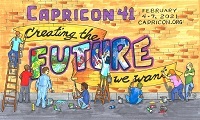
If the pandemic has taught us anything, many of its lessons are bitter and involve loss, disappointment, and loneliness. Good memories are few, but here’s one. This is what I wrote in February 2021 about the online version of Capricon, inspired by the poem “To the Fig Tree on 9th and Christian, by Ross Gay.” This year’s Capricon will be held on February 3 to 6, and I’ll be there! More about that in a coming post.
***
Capricon is a Chicago science fiction convention. We come together for four days in February at a hotel convention center, and we call ourselves family, except that in 2021 we did not come.
We met alone together, hundreds of us, with cameras, microphones, and keyboards, and we recreated what we could. Art, games, panels, films, freebies, kid’s activities, the guy in the goat costume, other people in costumes, music, parties — some with DJs — and of course the commemorative tee-shirt. It depicted a goat wearing a face mask.
At a science fiction convention, fans and authors, scientists and singers, costumers and gamers are the same, energized by ideas and self-expression. We gather to share our love for our mutual passions. It’s a tradition. The 2021 Capricon was the forty-first annual event.
With the freedom of non-meatspace we could welcome people from Vietnam, Brazil, Jamaica, Puerto Rico, and thirty-eight states, not just Chicagoland and those who could travel. No hugs, but we enjoyed a wider horizon and intentional inclusion. We had special early hours so distant fans could share their dinner with our breakfast. Two hundred activities were offered to do over a four-day weekend, including bartenders to help you mix your own drinks at home during the evening parties. The box fort got built. Bar Fleet had its discotheque, this time virtual, not in a hotel suite crowded to sweaty capacity.
At a Zoom panel I ran, discussing the power of the short story, we wondered how short a short story could be, and an audience member wrote a three-word story in the chat box: “Hindsight is 2020.” There was a lot to unpack in that, but I just laughed, glad to be looking back.
Our convention had a theme: “Creating the Future We Want.” We talked about the future, and how it was made, both by intention and opportunity. We considered various futures after global warming. With or without police. With or without forgiveness. With enough room for a few grudges to hold their distance. With enough closeness to fill the space with thanks.
We tried so hard to have fun, to give each other fun, to be the family again.
We set out our intentions for the coming year’s convention with the theme of music, and we planned to meet at a hotel already reserved, brick and mortar, flesh and blood. We hoped to have again the future we were working to create. Sing us in, 2022.
January 19, 2022
2021 publishing roundup – update
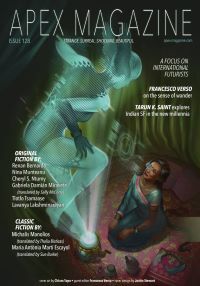
I’ve discovered that one more work of mine appeared in 2021, a republication of my translation into English of the short story “Francine (draft for the September lecture)” by Maria Antònia Martí Escayol, at Apex Magazine on December 28. This evocative, haunting story will make you wonder what’s real: after Renée Descartes’s daughter dies, he and his fellow scientists try to bring her back to life using 17th-century science.
As a reminder, here are my works that were first published in 2021 (and eligible for awards):
Immunity Index, a novel, published by Tor (read an excerpt). It’s about a coronavirus epidemic, but a much better one than our own covid-19 — because it’s over at the end of the book. Also, the novel includes a very loveable woolly mammoth.
“Embracing the Movement” by Cristina Jurado, which I translated into English, published in Clarkesworld Magazine’s June 2021 edition. The original short story, “Abrazar el movimiento,” won Spain’s Ignotus Award for Best Short Story 2021, the equivalent of a Hugo Award. The story’s lush prose hides horror.
Two of my short works were republished in 2021:
“Who Won the Battle of Arsia Mons,” a novelette about robots in a fight to the death on Mars, in Clarkesworld Year Twelve: Volume One (Clarkesworld Anthology).
“In the Weeds,” a short story about plants fighting climate change, in Over the Edge Again: The Edgy Writers Anthology. Other members of the Edgy Writers Critique Group shared some thoughts about their stories in these posts: “Sport” by Z Jeffries, and “Wild Heart” by Samuel Durr.
January 12, 2022
Guest post: conflict through misunderstanding
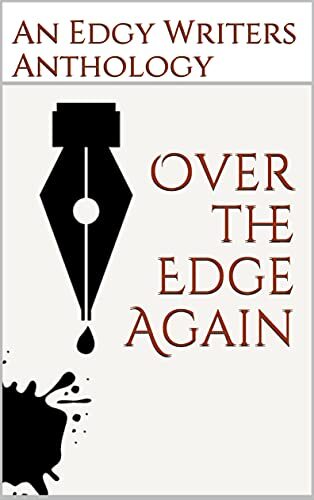
My writers critique group here in Chicago recently released an anthology, Over the Edge Again: An Edgy Writers Anthology .
In this essay, Z Jeffries shares the story behind his story in the anthology, “Sport.”
***
I was eight years old when I was given Frank Miller’s The Dark Knight Returns. For those reading who don’t know, it is a very violent, very adult comic book. I didn’t read it at that age, thank God. I totally saw some inappropriate art on those pages before I probably should have, but I didn’t read it until I was in my early teens. I was still too young to have read it then.
I also vividly remember watching the film Lord of the Flies when I was too young. It turned my stomach and made me cry, but I couldn’t look away.
I think most of us have stories like this: consuming media before it was appropriate. There is a suddenness in experiencing something through storytelling and/or art before our mind understands the context. The jarring feeling of consuming media about sex or violence before we’re ready comes with a high. Sure, forbidden acts give a jolt of adrenaline, but being faced with concepts foreign to us creates a misunderstanding. I believe this type of misunderstanding is a universal concept most people experience growing up.
There’s an old theatre anecdote that I love to apply to my writing. Two actors are in a scene on a dinner date. The director (or teacher) asks the actors where they are. One actor thinks they’re in a fine dining restaurant, the other says they’re in a fast-food joint. The actors are in conflict through misunderstanding, and that conflict affected the scene. That conflict made this an anecdote that has now been passed along.
Conflict is key to fiction, that’s a basic principle. I’m sure there are obscure exceptions, but conflict is paramount to a good story. If all characters are in agreement, there’s no tension, no stakes, no story. But while it’s fun to read about opposing characters butting heads, I believe one of the most underrated forms of conflict is misunderstanding. Sure, fight scenes and clever wordplay can entertain, but misunderstanding can make a reader too afraid for the main character to even continue reading.
Here’s another scenario for the theatrical scene — both actors are in a fine dining restaurant, only for one, it’s the fanciest restaurant they’ve ever been to, while for the other, it’s a sad place that reminds them of an ex. They’re in the same location, but each character has a context that creates a conflict through misunderstanding. Is this a fancy place or one that is sad and full of memories? That question affects the scene — are they celebrating or sadly reminiscing?
And isn’t that almost always true of settings in real life: the context of our experiences colors our perception of the world around us. We carry our context with us into each scene, creating our own reality by how we perceive it.
I feel disingenuous when my characters share context about their surroundings. I feel like someone’s perspective has been lost if they both exist in the same setting with the same context.
Writing younger characters allows another fun way to skew perspective: ignorance. Everything a person knows was learned and there was a time before that person had learned it. So it’s fun for young characters to be incorrect, to misunderstand the meanings of words, to misinterpret the context of a situation.
A gap of knowledge in which the reader or audience understands something a character does not is known as dramatic irony. It’s useful for creating tension (oh no, don’t go in there, favorite character of mine!) as well as creating sympathy (it’s not their fault, they didn’t know any better!). With younger characters, most books are filled with dramatic irony.
In my short story “Sport,” the point-of-view character is young and prone to misunderstanding. I had a chance to really play with an unreliable narrator. John Jarris isn’t lying, incapacitated, or mentally ill, common types of unreliable narrators. John Harris just doesn’t understand the adult situation his family is in, in a very similar way to the pictures in Frank Miller’s Dark Knight Returns I didn’t understand.
Hopefully, understanding what John Harris does not will give the reader an emotionally impactful experience. I wonder if anyone who knows of Frank Miller’s work might have gasped a little reading the opening line to this blog, might have had a tiny one-sentence-worth of an emotionally impactful experience.
In “Sport,” John Harris, this innocent boy, worries about the fate of fictional heroes, while it’s the reader who knows John Harris’s world is crumbling around him. The burden of this boy’s reality is borne by the reader, gasping as this kid reads his comic books.
January 5, 2022
2021 words of the year: few surprises

What the hell did we just live through? In case, like me, some of your memories are already getting hazy, here are some reminders. Various dictionaries and websites have announced their words of the year.
Merriam-Webster’s Dictionary 2021 word of the year is vaccine. “In everyday use, words are useful tools that communicate assertions, ideas, aspirations, and uncertainties. But they can also become vehicles for ideological conflict,” the Merriam-Webster website says. “The biggest science story of our time quickly became the biggest debate in our country, and the word at the center of both stories is vaccine.”
NPR notes the choice with the headline, “Merriam-Webster’s 2021 word of the year is, of course, ‘vaccine.’” Of course.
For Oxford, the word is vax. “When our lexicographers began digging into our English language corpus data it quickly became apparent that vax was a particularly striking term. A relatively rare word in our corpus until this year, by September it was over 72 times more frequent than at the same time last year.”
NPR notes dryly, “It would have been pretty difficult to get through 2021 without hearing the word vax at least once.”
For Cambridge, the word is perseverance. “It’s a word that perfectly captures the undaunted will of people across the world to never give up, despite the many challenges of 2021.” But that’s not all Cambridge has to say. “Prior to 2021, perseverance didn’t appear noticeably in lookups on the Cambridge Dictionary website. However, a spike of 30,487 searches for perseverance occurred between 19–25 February 2021, after NASA’s Perseverance Rover made its final descent to Mars on 18th February.”
By contrast, Collins Dictionary’s word of the year is NFT, the abbreviation for non-fungible token, the unique digital identifier that records ownership of a digital asset, a word that has nothing to do with the pandemic. One of its runner-up words, however, is double-vaxxed.
CNN points out in its commentary to the Collins choice that NFTs made the news in 2021. Yes, there was news besides the pandemic.
Because I speak Spanish, I’m interested in las palabras del año as well.
The FundéuRAE [Spanish Royal Academy Foundation] has chosen vacuna [vaccine]. “Everyone wants to picture the hope this word brings us, which is the beginning of the end of the pandemic.” Last year’s word was confinamiento [lockdown], and, Fundéu says, “the word of the year for 2022 could be very different.”
Other candidates for the Fundéu’s word of the year include cámper [camper van], carbononeutralidad [carbon neutral], criptomoneda [criptocurrency], negationista [denier], and variante [variant].
Meanwhile, readers of La Página del Idioma Español [The Page of the Spanish Language], have chosen covidiota, a word created in 2021 from the English word covidiot. The word resiliencia [resilience] came in second.
Although I don’t speak Catalan, the language used in northeastern Spain, there the word negacionisme [denialism] has been chosen as the word of the year by voters in a poll run by the Neology Observatory of the Department of Translation and Language Sciences at the Pompeu Fabra University and the Institute of Catalan Studies. The word podcast came in second place.
In case you’ve forgotten the year 2020 (lucky you), here’s my post about those words of the year. They also involve a lot of coronavirus-related terms.
In other year-end news, the Time Magazine Person of the Year is Elon Musk. An opinion piece at Politico says it should have been Rupert Murdoch, “someone who is both undeniably influential and undeniably malevolent. It was always the magazine’s intention to recognize impact, not virtue.”
The National Toy Hall of Fame has inducted three playthings for 2021: American Girl Dolls, the board game Risk, and the “universal plaything” sand. There’s nothing like a sandbox to inspire the imagination, even at my age.
December 22, 2021
Some links before the holidays
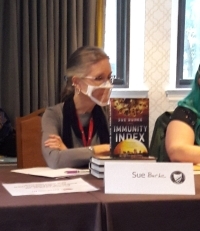
I’ve had a busy month so far.
On December 10 and 11, I was on a couple of panels at C2E2. At the first panel, science fiction writers Timothy Zahn, Delilah S. Dawson, J.S. Dewes, and I discussed world-building — and Andrew Warrick of The Beat took notes and wrote an article about the hour-long panel. Many people in the audience wanted to learn more about how to write, and we shared what we’ve learned along the way.
The next day at C2E2, J.S. Dewes and I talked about women in science fiction, and Andrew Warrick was back. His article is almost as good as being there.
***
Blogger Tasshin has written a long and thoughtful post about ethics in the Semiosis duology. In particular, he discusses the moral character of Stevland, the rainbow bamboo. Beware, the analysis contains spoilers.
***
Finally, I attended Discon III, the World Science Fiction Convention held in Washington, DC, from December 15 to 19. For obvious reasons, simply holding an event for 2000 people involved monumental challenges, but everyone was vaxxed and masked and, as of this writing, it doesn’t seem to have been a superspreader event.
Among the activities, I took part in a panel called “2020 Ruined My Novel.” Other writers spoke about how they’d faced problems with works in progress due to pandemic distractions or plots that had to be changed. I had a novel published about a coronavirus epidemic during the pandemic — with a coronavirus in the cover art!
I explained that the book, Immunity Index, differs greatly from our reality. “It has a happy ending,” I said, “because it has an ending.” With that tempting description, I managed to give away a few copies for holiday reading.
May 2022 be better for us all!



